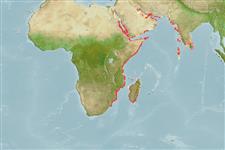Classification / Names
Common names from other countries
Main reference
Size / Weight / Age
Max length : 50.0 cm TL male/unsexed; (Ref. 5213); common length : 35.0 cm TL male/unsexed; (Ref. 5450)
Environment
Marine; reef-associated; depth range ? - 55 m (Ref. 68964)
Climate / Range
Tropical, preferred 27°C (Ref. 107945); 30°N - 35°S, 32°E - 85°E
Distribution
Western Indian Ocean: Persian Gulf (Ref.80050) and Red Sea south to Natal, South Africa, Mauritius, Madagascar and Comoro Islands. Reported as likely at Seychelles (Ref. 1623) but Randall and van Egmond 1994 (Ref. 10685) believe otherwise.
Countries | FAO areas | Ecosystems | Occurrences | Introductions
Short description
IUCN Red List Status (Ref. 115185)
Threat to humans
Harmless
Human uses
Fisheries: commercial; gamefish: yes
More information
ReferencesAquacultureAquaculture profileStrainsGeneticsAllele frequenciesHeritabilityDiseasesProcessingMass conversion
Tools
Special reports
Download XML
Internet sources
Estimates of some properties based on models
Phylogenetic diversity index
PD50 = 0.5000 many relatives (e.g. carps) 0.5 - 2.0 few relatives (e.g. lungfishes)
Trophic Level
4.0 ±0.66 se; Based on food items.
Resilience
Medium, minimum population doubling time 1.4 - 4.4 years (Preliminary K or Fecundity.)
Vulnerability
Moderate vulnerability (41 of 100)
Price category
